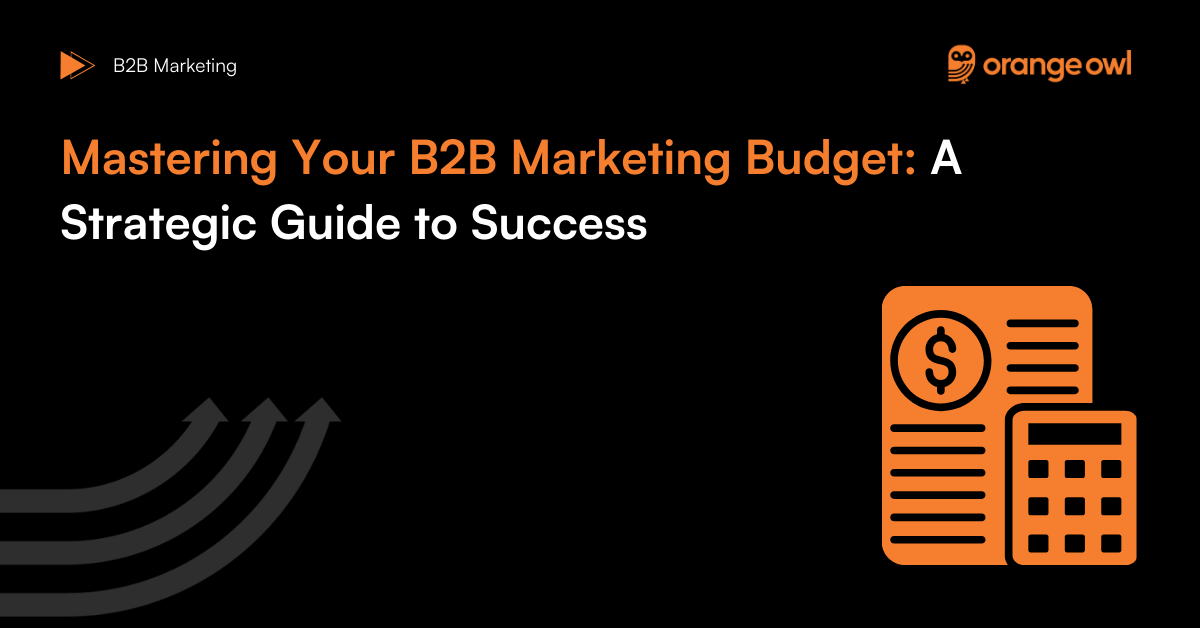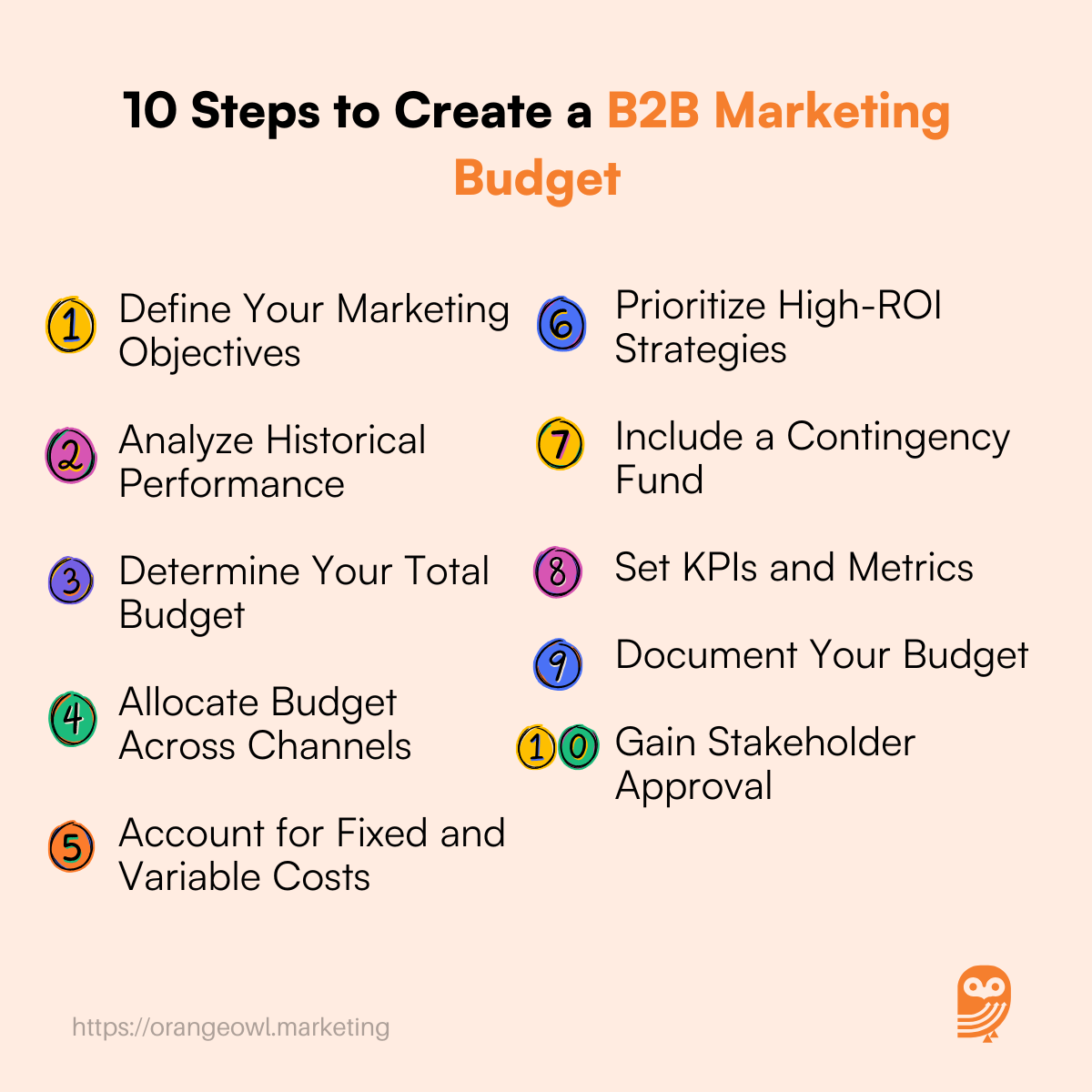Mastering Your B2B Marketing Budget: A Strategic Guide to Success
Vivek Goel
December 24, 2024

Table of Contents
Introduction
In today’s competitive B2B landscape, marketing plays a pivotal role in driving business growth. Unlike B2C, B2B marketing involves longer sales cycles, multi-stakeholder decision-making, and more complex buyer journeys. Crafting a well-structured marketing budget is essential for aligning your resources with strategic objectives and ensuring the success of your campaigns.
A well-planned B2B marketing budget acts as a blueprint for resource allocation, helping businesses focus on high-impact strategies, track ROI, and adapt to changing industry dynamics. This guide outlines a comprehensive approach to creating and managing your B2B marketing budget, avoiding common pitfalls, and leveraging data to maximize results.
What is a B2B Marketing Budget?
A B2B marketing budget refers to the planned allocation of financial resources a business dedicates to its marketing efforts aimed at other businesses. This budget is crafted to support strategies, campaigns, tools, and activities that help generate leads, nurture prospects, and build long-term relationships with other businesses.
Key Components of a B2B Marketing Budget
- Content Creation: Includes blogs, whitepapers, case studies, eBooks, and videos tailored to the target audience.
- Digital Marketing:
- SEO: For optimizing websites and content.
- PPC Advertising: Campaigns on platforms like Google Ads or LinkedIn.
- Social Media Marketing: Paid and organic strategies for platforms like LinkedIn and Twitter.
- Events and Webinars: Costs related to organizing or attending industry events and hosting webinars.
- Marketing Automation Tools: Subscriptions for tools like HubSpot, Marketo, or Salesforce.
- Email Marketing: Includes tools, templates, and campaign management.
- Market Research: Investments in understanding market trends, competitors, and customer behavior.
- Branding: Design and production of logos, brochures, banners, and other materials.
- Public Relations (PR): Media outreach, press releases, and reputation management.
- Sales Enablement: Tools and content to support the sales team, like proposal templates or CRM integration.
- Analytics and Reporting: Tools to measure and optimize campaign performance.
Why Is a B2B Marketing Budget Important?
A B2B marketing budget is more than just a financial outline. It serves as a strategic framework that:
- Aligns Goals with Resources: Ensures your budget supports critical business objectives like lead generation, customer retention, and sales enablement.
- Improves Decision-Making: Guides the prioritization of campaigns, tools, and resources based on ROI potential.
- Monitors Expenditures: Prevents overspending by systematically tracking where and how funds are utilized.
- Facilitates Long-Term Planning: Helps create scalable strategies by leveraging historical data and identifying recurring patterns.
- Adapts to Market Shifts: Provides the flexibility to pivot when faced with emerging trends or unexpected challenges.
- Drives ROI Measurement: Empowers marketing teams to measure campaign performance and justify expenditures with data.
A strategic budget ensures every dollar spent moves you closer to your business goals while minimizing waste and inefficiency.
10 Steps to Create a B2B Marketing Budget
1. Define Your Marketing Objectives
Start by identifying clear, measurable objectives that align with your sales funnel. Your objectives might include:
- Generating a specific number of marketing-qualified leads (MQLs) per quarter.
- Achieving a defined percentage increase in website traffic from target industries.
- Expanding brand awareness in emerging markets.
- Enhancing retention rates among existing customers by a set percentage.
Tie these objectives to tangible outcomes, such as revenue growth, and ensure they reflect realistic, data-driven expectations. Defining objectives first provides a foundation for determining how much to allocate and where to spend.

2. Analyze Historical Performance
Reviewing past performance helps identify what worked and what didn’t. Focus on:
- Channel Effectiveness: Evaluate the ROI from campaigns on LinkedIn, Google Ads, webinars, and content marketing.
- Customer Acquisition Costs (CAC): Determine the cost-effectiveness of various strategies and tools.
- Lead Quality: Assess the conversion rate of leads from different campaigns to identify high-performing sources.
- Sales Velocity: Measure the time it takes to convert a lead into a customer.
Analyzing this data helps forecast future performance and guides smarter allocation of resources.
3. Determine Your Total Budget
Estimate how much your organization should spend on marketing. Most B2B companies allocate 7-12% of annual revenue to marketing. Key considerations include:
- Growth Goals: Higher growth targets may require increased spending.
- Industry Benchmarks: Compare your budget to similar companies in your sector.
- Sales Cycle Complexity: Longer cycles may require more nurturing, impacting content and campaign investments.
- Product/Service Pricing: High-ticket products may justify a higher marketing spend per lead.
Having a baseline budget ensures your strategies align with business capabilities and objectives.
4. Allocate Budget Across Channels
Allocate resources strategically across the most impactful channels for your target audience:
- Digital Marketing: Prioritize platforms like LinkedIn for professional networking, Google PPC for targeted traffic, and email marketing for nurturing leads.
- Content Marketing: Invest in high-value assets like case studies, whitepapers, blogs, and webinars to build trust and authority.
- Account-Based Marketing (ABM): Dedicate resources to personalized campaigns targeting high-value accounts.
- Events and Trade Shows: Budget for participation in industry-specific events that offer networking opportunities and visibility.
Use performance data to determine the percentage of your budget allocated to each channel, ensuring it aligns with your target market’s behavior and preferences.
5. Account for Fixed and Variable Costs
Understanding your fixed and variable costs allows for more precise budgeting:
- Fixed Costs: Include subscription fees for tools like HubSpot, Salesforce, or Marketo, as well as salaries for in-house marketing teams.
- Variable Costs: Cover ad spending, outsourced content creation, or event sponsorship fees.
Create a balance between predictable expenditures and flexible investments to adapt to new opportunities.
6. Prioritize High-ROI Strategies
Focus on initiatives that deliver measurable results. Examples include:
- SEO Optimization: Invest in organic strategies to drive long-term traffic growth.
- Lead Nurturing Campaigns: Use email automation to convert leads more effectively.
- Targeted PPC Campaigns: Run hyper-focused campaigns to generate high-quality leads quickly.
- Customer Retention Programs: Allocate resources to loyalty initiatives that improve retention and CLV.
Prioritization ensures resources are directed to strategies with proven success.
7. Include a Contingency Fund
Marketing landscapes change rapidly. Allocate 5-10% of your budget for:
- Testing new channels or tools.
- Capitalizing on unexpected opportunities.
- Addressing unforeseen challenges, such as algorithm updates or platform changes.
A contingency fund ensures agility without disrupting core activities.
8. Set KPIs and Metrics
Tracking progress through clear KPIs is essential for monitoring success. Examples include:
- Marketing Qualified Leads (MQLs): Track the number and quality of leads passed to sales.
- Customer Lifetime Value (CLV): Measure the long-term revenue potential of customers acquired through marketing efforts.
- Cost per Lead (CPL): Calculate how much is spent to generate a single lead.
- Pipeline Contribution: Evaluate how much of the sales pipeline can be attributed to marketing activities.
Define metrics for each campaign and regularly analyze them to gauge effectiveness.
9. Document Your Budget
Maintain a detailed record of your marketing budget using tools like Excel, Google Sheets, or budgeting software. Include:
- Allocations by channel and campaign.
- Actual versus projected spending.
- ROI calculations for each initiative.
Documentation ensures transparency and accountability while simplifying stakeholder reporting.
10. Gain Stakeholder Approval
Present your budget plan to key stakeholders with:
- A clear connection between expenditures and business outcomes.
- Data to support proposed allocations.
- Projected ROI for high-impact strategies.
Engaging stakeholders early builds trust and ensures alignment between marketing and organizational goals.
Tips for Managing Your B2B Marketing Budget
- Leverage Marketing Tools: Use platforms like HubSpot or Marketo for efficient budget tracking and analytics.
- Track Spending Consistently: Monitor your budget regularly to ensure alignment with goals.
- Optimize Campaign Performance: Continuously refine campaigns based on performance data.
- Adjust Dynamically: Stay flexible to adapt to changes in market conditions or internal priorities.
- Engage Stakeholders: Regularly communicate updates on budget status and campaign performance.
Common Pitfalls to Avoid
- Neglecting ROI Tracking: Failing to track ROI undermines efforts to justify expenditures.
- Overlooking Hidden Costs: Include all associated costs, such as training and maintenance, in your calculations.
- Underfunding Key Channels: Avoid spreading your budget too thin, which can reduce the impact of effective channels.
- Ignoring Industry Trends: Stay informed about emerging trends and technologies to remain competitive.
- Focusing Only on Short-Term Results: Balance short-term gains with investments in long-term growth initiatives.
Conclusion
A well-structured B2B marketing budget is a cornerstone of success. By aligning resources with goals, leveraging data, and maintaining flexibility, businesses can achieve sustainable growth and adapt to market demands.
Invest in building a strategic, data-driven budget that empowers your marketing team to deliver impactful campaigns and measurable results. With the insights from this guide, you’re ready to transform your B2B marketing budget into a powerful driver of long-term success.
Frequently Asked Questions(FAQs) on B2B Marketing Budget
A marketing budget is a financial plan that allocates resources for various marketing activities over a defined period, usually annually or quarterly. It includes funding for campaigns, tools, staff, and other resources. The importance of a marketing budget lies in its ability to:
- Optimize Resource Allocation: It helps businesses allocate the right amount of resources to various marketing initiatives, ensuring the most impactful activities are funded.
- Align with Business Goals: A well-planned budget ensures that marketing efforts are aligned with the company’s broader business objectives, whether it’s increasing brand awareness, generating leads, or driving sales.
- Track and Control Spending: It provides a clear overview of expenditures, helping to control costs and avoid overspending. This level of tracking is crucial for maintaining financial discipline and profitability.
- Measure ROI: With a set budget, businesses can assess which marketing strategies provide the best returns, refining future strategies and investments.
Deciding how much to spend on marketing depends on several key factors:
- Business Size: Larger businesses with bigger revenue streams may allocate a higher absolute amount to marketing, while smaller businesses often spend a smaller percentage but still aim for a significant impact.
- Industry Norms: Marketing spending varies by industry. For example, B2B companies may allocate a different percentage of their budget compared to B2C companies due to differences in sales cycles and customer acquisition costs.
- Growth Goals: Businesses aiming for rapid growth or expansion into new markets might allocate a larger portion of their revenue to marketing to boost visibility and generate leads.
- Historical Data: Reviewing past marketing performance and the return on investment (ROI) from previous campaigns can guide the budget. If certain tactics have yielded great results, the budget for those activities might be increased.
- Marketing Objectives: The overall marketing strategy, whether it’s focused on brand awareness, lead generation, or customer retention, will impact how much is allocated. For example, if the focus is on lead generation, you might allocate more to paid advertising or lead nurturing activities.
A general rule of thumb for marketing spending is 5-10% of total revenue, though this varies based on the factors above.
A marketing budget includes several components, each critical for tracking and managing marketing expenses:
- Campaign Costs: This includes the costs associated with running specific marketing campaigns, such as advertisements (online and offline), event marketing, or promotions.
- Advertising Spend: This includes both traditional (TV, print, radio) and digital (Google Ads, LinkedIn Ads, Facebook Ads) advertising costs. A portion of the budget should be set aside for both short-term campaigns and long-term brand-building efforts.
- Tools and Software: Marketing tools for analytics (e.g., Google Analytics), CRM (e.g., HubSpot), email marketing (e.g., Mailchimp), social media management (e.g., Hootsuite), and content creation tools (e.g., Canva, Adobe Creative Suite) should also be factored into the budget.
- Personnel or Agency Fees: The cost of in-house marketing teams or outsourcing to agencies, consultants, or freelancers. These can be fixed costs, but it’s important to include any project-based or hourly fees.
- Content Creation: Budgeting for the production of marketing content like blogs, videos, infographics, and case studies. This can include costs for graphic design, copywriting, and video production.
- Event Marketing: If your business participates in trade shows, webinars, conferences, or other events, these costs should be included. Event marketing often requires expenses for booth design, travel, and event sponsorships.
- Contingency Fund: It’s always wise to allocate a small percentage (usually 5-10%) of the budget for unexpected expenses or new opportunities that arise throughout the year.
Marketing budgets should be reviewed regularly to ensure that spending is aligned with business goals and market conditions. A typical review schedule includes:
- Monthly: This is ideal for tracking short-term campaigns and adjusting spend based on performance data. If something isn’t working, you can adjust the budget quickly to ensure that resources are being used effectively.
- Quarterly: A quarterly review allows businesses to look at trends over a longer period. You can assess whether your marketing strategies are aligned with business objectives and make adjustments to spending priorities.
- Annually: An annual review is the most comprehensive, allowing for long-term planning and goal setting for the next year. This review should take into account the effectiveness of past strategies, shifts in the market, and the company’s growth trajectory.
- Fixed Costs: These are predictable and stable costs that do not change, regardless of how much marketing activity occurs. Examples include:
- Salaries of in-house marketing staff
- Software subscriptions (e.g., CRM or email marketing tools)
- Rent for office space used by the marketing team
- Retainer fees for agencies or consultants
- Variable Costs: These costs fluctuate based on marketing activity or campaign scope. They include:
- Paid Advertising (e.g., Google Ads, social media ads)
- Event Sponsorships
- Freelancer fees for content creation or design
- Promotions or Discounts offered in response to a campaign’s success or market conditions
Understanding the distinction between fixed and variable costs helps with managing cash flow and forecasting marketing expenses more effectively.
Small businesses can make the most of a limited budget by focusing on cost-efficient strategies:
- Content Marketing: Leverage the power of content to build brand visibility without a significant spend. Blogging, creating informative guides, and offering free resources (e.g., eBooks, webinars) can drive organic traffic and build trust.
- Social Media Marketing: Platforms like Facebook, Instagram, and LinkedIn offer free ways to engage with an audience. Small businesses can use these platforms to share valuable content, engage in conversations, and increase brand awareness without a large financial investment.
- Email Marketing: Use free email marketing tools like Mailchimp for building email lists, sending newsletters, and nurturing leads. It is an affordable way to reach your audience directly.
- Networking and Referrals: Networking through local events, online communities, or industry groups is a cost-effective way to gain new clients. Encouraging referrals from existing clients can generate leads at minimal cost.
- DIY Tools: Free tools for social media management, graphic design, and analytics can help businesses keep costs low. For example, using Canva for design or Google Analytics for tracking website traffic.
ROI (Return on Investment) is crucial for measuring the effectiveness of your marketing spend. Tracking ROI allows businesses to understand which campaigns are delivering value and which are not. It helps to:
- Optimize Spending: If a particular channel, like paid social media ads, is providing a high ROI, businesses can reallocate more budget toward it.
- Maximize Marketing Efficiency: Regularly evaluating ROI helps to identify the most cost-effective marketing strategies, allowing businesses to cut out ineffective activities and invest in higher-performing ones.
- Support Decision Making: Understanding the ROI of various strategies guides budget decisions in future cycles. If a marketing activity is not yielding sufficient ROI, adjustments can be made, such as altering messaging, targeting, or spending levels.
Market trends can have a significant impact on how businesses allocate their marketing budget. Here are a few examples:
- Consumer Behavior: As trends shift, such as a greater emphasis on mobile-first experiences or the growing importance of sustainability, businesses must adjust their marketing strategies accordingly.
- Technological Advances: New tools, platforms, or channels, such as the rise of AI-powered marketing or the popularity of TikTok, may require businesses to allocate more budget toward emerging technologies or platforms.
- Seasonality: Many industries experience seasonal fluctuations, requiring businesses to ramp up marketing spend during peak times (e.g., holidays) and adjust accordingly during off-peak times.
- Competitive Landscape: If competitors invest heavily in new technologies or aggressive advertising, it may force businesses to increase their own marketing budgets to maintain market share.
Adjusting the marketing budget to stay aligned with market trends ensures that marketing efforts remain relevant and impactful.
Several common mistakes can lead to inefficiencies in managing a marketing budget:
- Underestimating Costs: Failing to account for hidden costs (e.g., ad hoc expenses, unexpected project needs) can derail a budget quickly.
- Neglecting to Track Expenses: Without regular monitoring of spending, businesses may exceed their budget without realizing it.
- Over or Underinvesting in Channels: Allocating too much to one channel while neglecting others can reduce overall marketing effectiveness. On the other hand, underfunding high-potential channels can result in missed opportunities.
- Not Adjusting to Market Changes: Not revisiting the budget in light of new opportunities, shifts in consumer behavior, or emerging trends can result in missed opportunities to optimize the marketing spend.
Avoiding these mistakes requires regular monitoring, flexibility, and an understanding of both internal and external factors that influence your marketing budget.
Yes, a well-structured marketing budget is critical for long-term planning. It provides insights into:
- Resource Allocation: Over time, tracking how resources are distributed across channels helps businesses optimize their strategies and allocate resources more effectively.
- Forecasting Future Needs: Analyzing past budgets and marketing campaigns helps predict future marketing expenses based on historical trends and growth plans.
- Goal Setting: By aligning the budget with long-term business goals, companies can ensure that marketing efforts are focused on achieving these objectives, whether it’s market expansion, customer acquisition, or brand loyalty.
- Sustainable Growth: Long-term planning through budgeting helps businesses stay financially disciplined while making investments that drive sustainable growth.
In essence, a comprehensive marketing budget is a strategic tool for both short-term and long-term planning, ensuring consistent growth and success.


